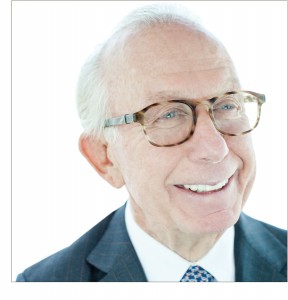Trending
The Closing: Leonard Boxer
The attorney discusses his childhood in Brooklyn, working as a code-breaker <br/>for the Army and helping Larry Silverstein win the World Trade Center lease

From the LeFrak Organization to Donald Trump, most major real estate developers in New York have called upon attorney Leonard Boxer at some point over the last five decades. Boxer cut his teeth in real estate law under the tutelage of the late developer Robert Olnick, whose credits included Starrett City. Today, Boxer heads Stroock & Stroock & Lavan’s real estate practices, where his notable deals have included helping Larry Silverstein raise the equity to acquire the long-term lease of the World Trade Center in 2001, just weeks before the Sept. 11 attacks. Boxer still carries a worn billfold containing his ID for 1 World Trade Center. “It was a great accomplishment when we did it,” he said, “But look what happened after that.”
 Name: Leonard Boxer
Name: Leonard Boxer
Born: February 11, 1939
Hometown: Brooklyn
Marital status: Married 49 years
Children: 3 sons
Tell me about growing up in East Flatbush.
I lost my father when I was a year old and my mother went to work [as an executive secretary]. We lived with my mother’s parents. When I graduated Erasmus Hall High School, my grandfather, who was paying for my education, said, “You can go to any school that you get into, but you’ve got to come home at night.” I ended up going to New York University.
What did you study?
I got my original degree in accounting and worked as an accountant through undergraduate school. When I graduated, I decided I wanted to be a lawyer, and went to NYU Law School.
Did you work through law school, too?
When I was in law school, flights to Kennedy Airport were inundating the immigration service. They came to NYU Law School and selected three of us to become immigration officers during the summer, which was a great job. It paid very well and here I was, single, with all these stewardesses.
What did you do next?
When I graduated law school [in 1963] it was the height of the Vietnam War. There was an opening in the Army Security Agency’s school in Fort Devens, Massachusetts. At the time, it was a top-secret facility where they taught us to break codes. Now you have computers that do it.
Was real estate the end goal?
Absolutely not. I had no clue. My original objective was to become a tax lawyer. You know, all the best laid plans. … It was just fortuitous that I ended up meeting Robert Olnick.
How did you meet him?
After the service, I got what was considered a coup, a job at a surrogate’s firm in Brooklyn, specializing in trusts and estates. After a year and a half, I ran into a law school classmate, who’d been offered a job with Robert Olnick. He decided he had a better offer and said, “Why don’t you meet Mr. Olnick?” I told Mr. Olnick I had no experience in real estate. He said, “Don’t worry, in six months we’ll find out if you can be a real estate lawyer.”
You make it seem like great timing, luck.
It was great timing. The city had problems. We were on the forefront of all the major issues that we’re facing today, like [a lack of] low- and middle-income housing. We became very intimately involved in crafting programs that created housing.
You’ve worked on more than 1,000 deals, correct?
I have represented most of the major real estate people in New York. … People know they can trust me. If there’s a unique skill that I have, it’s a people skill.
Is there a project you’re most proud of?
Well, I walk down the street and most of the buildings, I’ve had something to do with. I guess the one transaction that’s kind of bittersweet for me is I represented Larry Silverstein in his acquisition of the World Trade Center. He was the dark horse. Every major developer in the country was after that transaction.
Who’s a tougher client, Mr. Silverstein or Mr. Trump?
[Laughs.] It’s not so much tougher. They both have their own idiosyncrasies. They’re both very successful, they’re both very driven. At the end of the day, I’ve gained their friendship and that, to me, is very important.
How has your role evolved?
In the old days, I did every aspect of a transaction. Now I quarterback the transaction.
How do you relax?
Golf is a great catharsis. You spend a couple of hours worrying about different things on the golf course. It takes your mind off what your real issues are.
Where do you live?
78th and Park Avenue. We’ve lived there for about 12 years. I have a summer place in Westchester, down the road from the Golf Club of Purchase.
Do you think you’ll retire anytime soon?
As long as I continue to be healthy, I wouldn’t want to retire. I relish what I do. A good part of what I’m involved with are charities. I believe in giving back.
What’s a word or two you’d use to describe yourself?
Listen, I don’t have an ego. I think I’m a nice person who has created a reputation of being trustworthy and honest, and having the ability to get things done.
What’s the best piece of advice you’ve gotten?
Respect for people, whoever they are. When I merged my firm into Stroock, I made sure every person — not only the lawyers — but every person in our mailroom was also taken care of. I didn’t forget where I came from and who helped me get there.
How many contacts are there in your address book?
I must have 10,000. They’re trying to transition [them] to my iPhone and it’s almost out of space.
Who is on your speed dial?
Basically my wife and my three boys.
How have you used your connections to help someone?
[NYU President] John Sexton is one of my close friends. We were neighbors in Belle Harbor, [Queens]. I helped him become dean of the law school. I was representing Larry Silverstein, who was close with Larry Tisch and Billy and Jack Rudin. They picked John as a long-shot candidate and the rest is history.
Thanks so much for doing this, Mr. Boxer.
Call me Lenny. I’m not a fancy guy. I’m a heimesche guy, that’s the bottom line.




